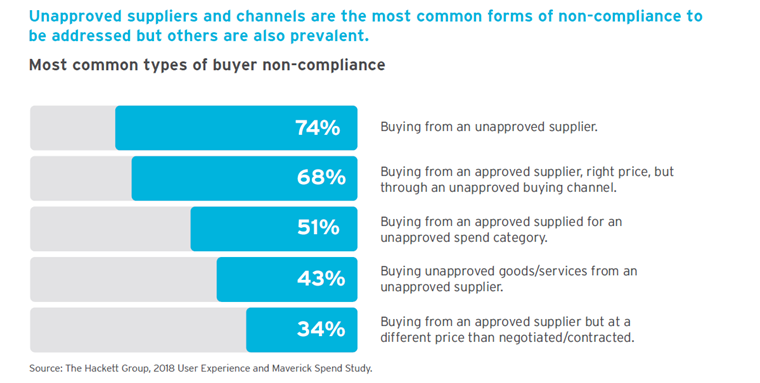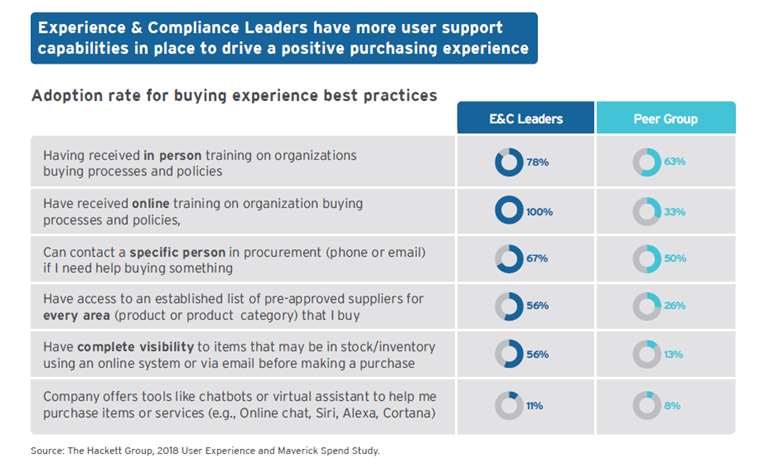- Blog
- Creating a Positive Spend Culture to Put an End to Maverick Buying
Creating a Positive Spend Culture to Put an End to Maverick Buying
Many companies lose 10-20% of targeted savings due to maverick buying, according to the latest study from The Hackett Group in conjunction with Basware.
If you’re involved with the procurement process at a medium or large company, you know that (despite the best intentions) not everyone follows your company’s compliance protocols. It most likely happens frequently. Dave in accounting purchases a new software product without putting the request through the proper channels, Tanya in HR buys printer paper without going to an approved vendor, and Todd in marketing decides to purchase the services of a freelance designer but does so through the wrong buying channel. This situation, known as maverick buying, is more common than employees might realise.
As you can imagine, consistently falling short of targeted savings by 10-20% adds up year after year — especially when factoring in all the other downsides that come with maverick buying such as internal conflict, distrust, and sluggish company processes.

Given this situation, why is maverick buying so common? The Hackett Group has pinpointed several culprits, but perhaps the single most important element is that too many companies have an unmanaged spend culture. As illustrated above, this culture reveals itself whenever employees decide they need to buy something they may not worry about compliance or have an understanding of why this is so important and the overall consequences to the business.
How do you break from these bad habits and create a positive spend culture?
Here are three suggestions to get you started.
1. Require stakeholder education & online training programs.
No one gets excited about the prospect of online training programs, especially since such programs have a reputation of being mind-numbingly boring and taking far more time than needed. And yet data shows that training may be the single biggest differentiator when it comes to separating those who have an effective procurement culture from those who do not. Specifically, The Hackett Group found that 100% of compliance leaders in their study offered such training, compared to only 33% of the peer group. That’s a notable difference.
Given this data, what your company might need above all else is an effective, direct training program that can spell out exactly why compliance matters and what noncompliance looks like. Without such a program, your employees might have no idea that their actions are hurting the bottom line (and therefore their own paychecks). So, find all stakeholders in the procurement process and get them trained.
2. Give complete visibility into inventory.
Another cause of maverick spending happens when people miscommunicate about inventory. Someone thinks that a purchase is necessary only to find out later that the company already has that product stored somewhere deep in inventory. Not only do these situations create unnecessary costs, but they also make people less likely to comply with procurement protocol since people start to believe that their process can’t be trusted, and no one has any idea what’s actually going on.
To fix this problem, give complete visibility to all items that may be in stock or inventory using an online system or via email. This single move can go a long way to changing your procurement culture, as evidenced by the fact that 56% of compliance leaders in the survey offered such visibility compared to only 13% of the peer group.

3. Consider a purchase-to-pay (P2P) platform.
One of the biggest differences when it comes to the bottom line has to do with those companies that implement a P2P platform. Namely, on average they get 60% lower lost savings from maverick buying than companies that have not implemented such a platform.
Why is that? In part it’s because company protocol can be built directly into the P2P software, guiding employees to see exactly how the process works. This might be in the form of choosing from selected vendors, warnings about incorrect channels, or alerts about pricing. Whatever the specifics, people can use the guidance and automation that comes with such software to make the entire procurement process less of a headache. And when something is easy to use and less of a burden, they’re far more likely to sign on and commit to it.
With careful training, complete visibility, and a purchase-to-pay platform, your team can start to reform bad habits and create the ideal procurement culture. And, given that you’ll likely save 10-20% in maverick spending, your bottom line will benefit as well. The trick is to find which of these options will work best in your business and analyse the most cost-effective strategy to make these ideas a reality. From there you’ll be on your way to completely changing your culture so that compliance isn’t just an afterthought. Instead, it will be a way of doing business.
Related
-
By Basware RepresentativeThe route to logistics software harmony for finance, AP and procurement
-
By Katarzyna FonteynA Reflection on the State of Procurement
-
By Katarzyna FonteynHow to create procurement visibility from day 1
-
By Basware RepresentativeDon’t Delay Digital Procurement & Finance Investments
-
By Ann StrömbergNordic Leaders Circle focused on procurement development
-
By Katie ColbourneProcure-to-Pay Trends Predictions and Advancements for 2022 and Beyond
-
By Basware RepresentativeBasware to Help Expand e-Invoicing with the Business Payment Coalition
-
By Ann StrömbergProcurement Collaboration, Resilience, Technology, and Sustainability

